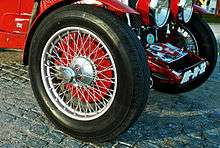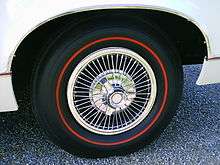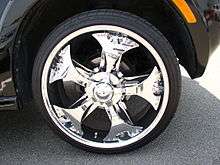Spinner (wheel)
The spinner on automobile wheels historically refers to knock-off hubs or center caps. They may be the actual, or intended to simulate, the design used on antique vehicles or vintage sports cars. A "spinner wheel" in contemporary usage is a type of hubcap or inner wheel ornament, that spins independently inside of a wheel itself when the vehicle is in motion, and continues to spin once the vehicle has come to a stop.
Original use


The spinner cap was introduced into the commercial vehicle and passenger automobile market in the 1930s.[1] The spinner or "knock-off" was designed to keep the wheel on the automobile. They were screwed on and "knocked on tightly" using hammers and tools, hence the name "knock-offs". Most setups will feature right-hand threads on the left side of the vehicle, and left-hand threads (rotate clockwise to remove) on the vehicle's right side so the screw-on spinner would stay tightened as the auto was in forward motion.[2] The knock-off spinners were used until the development of the lug nut method attaching the wheel.
During the 1950s automobile manufacturers offered simulated wire wheel covers for a look of luxury that featured criss-crossing spokes designed to look like the real wire wheels that were used on vehicles in the 1920s and 1930s.[3] These "spinner-wheel covers" were available on standard as well as featured on custom cars, and lowriders quickly adapted them for their own vehicles.[4]
During the early-1960s, the simulated wire wheel covers returned, but with new look designed to emphasize sportiness with their radiating spokes and center "spinner caps."[3][5] These classic center spinner caps feature a rigidly mounted propeller-like center element, usually with two or three projecting "blades."[6] They were intended to simulate the knock-off hubs that were used on vintage racing vehicles and classic sports cars where a hammer or special wrench was used on the spinner to release or tighten the wheel to the hub.[7]
These spinner hubcaps were most often an optional appearance upgrade to the standard equipment hubcaps or full wheel covers that attached to stamped steel wheels.[8]
In the late 1960s, U.S. Federal safety standards banned the use of protruding bar spinners on automobiles.[1]
Other uses
The mid-1950s Dodge four-bladed “spinner” wheel covers became an icons for the era and also became an item popular to owners to customize their cars.[9][10]
Spinners were add on accessory marketed during the 1950s to decorate regular wheel covers for a custom look.[11] Center spinner hubcaps were also available as original equipment from automakers.[12]
Custom wheels for lowriders also used naked ladies on wheel covers and these were the first to feature a floating or spinner-type wheel device. A bracket was used to mount to the spindle so while the lady stood still the wheel spun around.[13] Similarly, the Rolls-Royce Phantom has anti-spinners — the "RR" logo in the center of the hub is mounted on a spinner with an offset weight designed to ensure that the logo is always the right way up when the car is parked.
The hubometers used on large trucks, buses, and trailers that appear to be stationary while the wheel is turning to accurately measure the actual distance covered. They are actually enclosed and float in a liquid with anti-freeze as to be functional in severe low temperatures without freezing.
Modern concept

The modern spinner device is a decorative kinetic attachment to the wheel of an automobile.[14] The spinner covers the center of a car's wheel and is designed to independently rotate by using one or more roller bearings to isolate the spinner from the wheel, enabling it to turn while the wheel is at rest.[14]
Legislative bills were proposed in several states to ban spinner type wheels and hubcaps that simulate movement even when a vehicle is stopped because they could be disconcerting to other motorists and present a safety hazard.[15]
Spinners were popular during the early-2000s within the hip-hop community of the United States. Since the mid-2000s, they are gradually fading out of vogue in popular culture.[16][17]
Music
The spinner-type automobile hubcaps were the inspiration for a Detroit-area R&B/soul group, The Domingoes, to rename themselves The Spinners in the late 1950s.[18]
In 1960, Pat Davis recorded the song "Spinner Hub Caps".[19]
See also
References
- 1 2 Browne, Ray B.; Browne, Pat, eds. (2001). The guide to United States popular culture. Bowling Green State University Popular Press. p. 416. ISBN 9780879728212. Retrieved 9 October 2012.
- ↑ Mavrigian, Mike (2008). High Performance Fasteners & Plumbing : A Guide to Nuts, Bolts, Fuel, Brake, Oil & Coolant Lines, Hoses, Clamps, Racinghardware and Plumbing Techniques. HP Books. ISBN 9781557885234. Retrieved 14 November 2013.
- 1 2 Connor, Sean (22 January 2012). "A look back at simulated wire wheel covers. Part 2: the 1960s". Newark Classic Cars Examiner.
- ↑ Tatum, Charles M. (2011). Lowriders in Chicano Culture: From Low to Slow to Show:. ABC-CLIO. pp. 199–200. ISBN 9780313381492. Retrieved 9 October 2012.
- ↑ Gunnell, John (2006). Standard Catalog of American Muscle Cars 1960-1972. Krause Publications. p. 10. ISBN 978-0-89689-433-4. Retrieved 9 October 2012.
- ↑ Corcoran, Tom (1994). Mustang 1964½–1968. MBI Publishing. p. 27. ISBN 978-0-87938-630-6. Retrieved 9 October 2012.
- ↑ Clausager, Anders Ditlev (2003). Original MGA. MBI Publishing. p. 84. ISBN 9780760314500. Retrieved 9 October 2012.
- ↑ Cheetham, Craig (2007). Ultimate Muscle Cars. MBI Publishing. p. 74. ISBN 978-0-7603-2834-7. Retrieved 9 October 2012.
- ↑ Gunnell, John (2004). Standard guide to 1950s American cars. Krause Publications. ISBN 978-0-87349-868-5. Retrieved 9 October 2012.
- ↑ Kustom Kemps of America: Commemorative Book. Turner Publishing. 2003. ISBN 9781563119378. Retrieved 9 October 2012.
- ↑ Crow, Deette (2004). Rod & Custom in the 1950s. Motorbooks International. p. 209. ISBN 9780760316306. Retrieved 9 October 2012.
- ↑ Holder, Bill; Kunz, Phil (2003). Chrysler Muscle: Detroit's Mightiest Machines. Krause Publications. p. 22. ISBN 9780873496339. Retrieved 9 October 2012.
- ↑ Perea, Sammy J. (February 2009). "History of the Wheel: A loose look at the wheels and tires that lowriders have loved to roll on". Lowrider. Retrieved 9 October 2012.
- 1 2 Sobe, Ed (2009). A Field Guide to Automotive Technology. Chicago Review Press. p. 28. ISBN 9781613741719. Retrieved 21 November 2012.
- ↑ "Spinner wheels and hubcaps face bans in several states". SEMA Market Snapshot. 15 June 2005. Retrieved 11 June 2013.
- ↑ "Choosing the Best Tires for Your Car". Smartguy.com. 2008. Retrieved 11 June 2013.
- ↑ "How to Select New Rims and Tires for Your Car". Auto Parts & Accessories. 19 August 2012. Retrieved 11 June 2013.
- ↑ Marshall, Tim. "The 'One of a Kind' Sound of The Spinners". R&B Showcase News (7). Retrieved 9 October 2012.
- ↑ Schmidling, Tyrone (26 April 2009). "Pat Davis "Spinner Hub Caps" 1960". Youtube.com. Retrieved 11 June 2013.